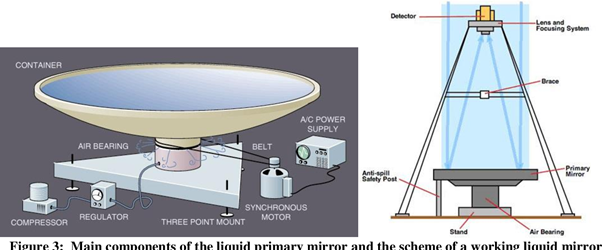

3rd June 2022 (7 Topics)
Context
India has commissioned a unique liquid-mirror telescope atop a mountain in the Himalayan region that will keep a watch on the skies to identify transient or variable objects.
About
About International Liquid-Mirror Telescope (ILMT):
- The telescope, commissioned at Devasthal, a hill in Uttarakhand.
- It is located at an altitude of 2450 metres at the Devasthal Observatory campus of Aryabhatta Research Institute of Observational Sciences (ARIES).
- ARIES is an autonomous institute under the Department of Science and Technology (DST), Govt. of India in Nainital district, Uttarakhand.
- It is the first liquid mirror telescope in the country and the largest in Asia.
- It will help in surveying the sky making it possible to observe several galaxies and other astronomical sources just by staring at the strip of sky that passes overhead.
- The unique telescope will monitor the sky for transitory or variable objects such as supernovae, gravitational lenses, space debris, and asteroids.
- It is built by astronomers from India, Belgium and Canada.
- The novel instrument employs a 4-meter-diameter rotating mirror made up of a thin film of liquid mercury to collect and focus light.
- The telescope was designed and built at the Advanced Mechanical and Optical Systems Corporation and the Centre Spatial de Liege, Belgium.
- The major instrumentation funding was jointly provided by Canada and Belgium while India will be responsible for the operations and upkeep of the telescope.
- The ILMT will operate every night for five years and carry out daily imaging except between June and August monsoon months, a precaution to protect the instruments from humid conditions.
How it works?
- The scientists from the three countries spun a pool of mercury which is a reflective liquid, so that the surface curved into a parabolic shape which is ideal for focusing light.
- A thin transparent film of mylar protects the mercury from wind.
- The reflected light passes through a sophisticated multi-lens optical corrector that produces sharp images over a wide field of view.
- A large-format electronic camera located at the focus records the images.
- The technology of liquid mirror (LM) telescope is relatively simple. ?Three components ?are required:
- ?A ?dish ?containing ?a ?reflecting ?liquid ?metal ?(essentially ?mercury),
- ?An ?air ?bearing ?on which ?the ?LM ?sits, and
- ?A drive system.

|
What is Mylar?
|




